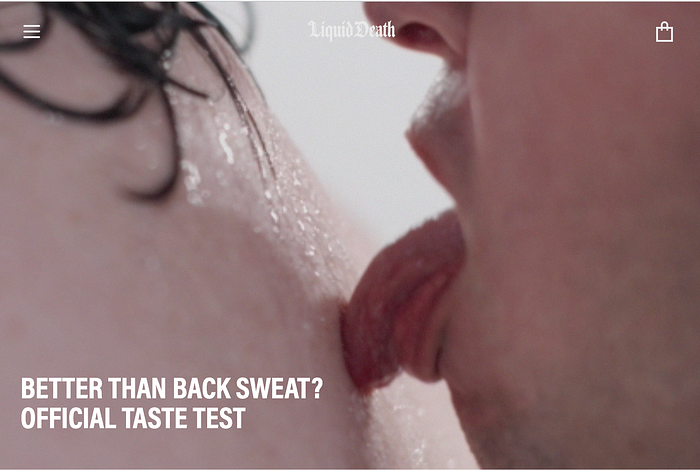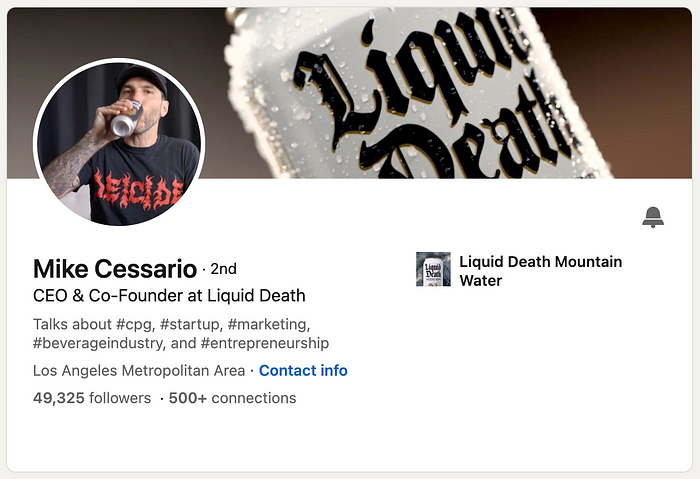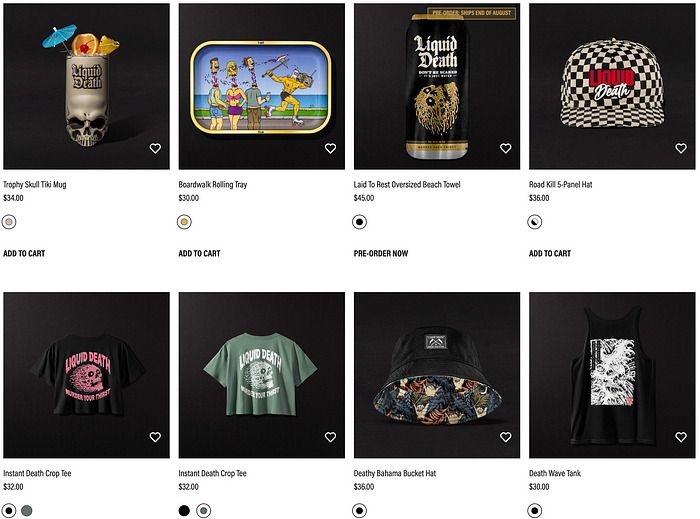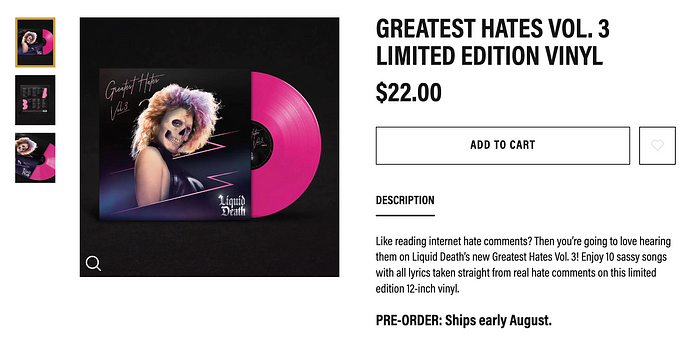16 Lessons I Learned From Studying the $700M Brand Liquid DeathHow founders and marketers can creat
 Screenshot from Liquid Death’s latest ad
Screenshot from Liquid Death’s latest ad
I’m not going to repeat the story of Liquid Death.
If you’re curious, CNBC Make It did an excellent interview with the founder Mike Cessario here. Mike Cessario’s Linkedin
Mike Cessario’s Linkedin
After consuming multiple hours of podcast interviews and just about every article I could find online on Liquid Death, I put together a “handbook” of takeaways I learned about branding and entrepreneurship for founders, marketers, and startups wanting to learn from Liquid Death’s playbook.
You’re just getting started with a new idea but you don’t know what to do with it… start right here.
1/ Prove the market exists before you even create the product. Founder Mike Cessario spent $1,500 to create an introductory marketing video that went viral — it received 3 million views in four months — the “product” in the video was a digital rendering and some white tallboy can the actor carefully held as she poured it out.
Liquid Death’s first video ever has 4.9m views.
2/ Just because nobody likes your pitch doesn’t mean it won’t work. Mike Cessario knew the idea alone wouldn’t be enough to raise funding. So he created a video and promoted it as if it was already an existing product to prove it would work.
3/ The brand you create should be born of your personality and beliefs. Mike Cessario was a creative director who worked at an advertising agency creating campaigns for some of the largest consumer brands in the world, including Nestle and Volkswagen. He was also a metalhead, grew up playing in punk bands, and loved standup comedy. Starting to see any similarities? The more you learn about the founder, the more you see where the brand comes from. Don’t create a brand you don’t viscerally believe in.
4/ Brand is more important than product. This will be a tough one for builders to get, but easy for marketers. Liquid Death is literally canned water. It’s infinitely commoditizable. The product alone is boring. The brand is the whole business. Liquid Death generates $50 million a year, roughly 10% coming from merch. Merch! Imagine people paying you to market your product. A strong brand is worth the extra time and creativity to develop. Don’t rush it. Liquid Death merchandise accounts for 10% of annual revenue
Liquid Death merchandise accounts for 10% of annual revenue
Next: You created something, great, and you just put it out there for people to interact with… now what?
5/ Failure does not mean failure. Mike Cessario first tried launching a liquor brand. It was called Western Grace, a cool brandy brand. It failed. Then he initially launched Liquid Death on the crowdfunding platform Indigogo and raised a total of $0.
6/ Think Wrong. Founder Mike Cessario’s favorite and most recommended book is Think Wrong for throwing away the traditional marketing playbook and coming up with category-shattering creative ideas.Mike Cessario’s favorite book on creativity
7/ Tell the same story, over and over and over and over and over. In every single interview, Mike Cessario tells the same story about how he was backstage at a death metal concert and he noticed all the opened Monster energy cans the musicians were drinking, but then a friend said to him, “You know they’re filled with water, right?” And that’s the aha moment the idea for Liquid Death was born. It’s a good story. It presents new information nobody has ever thought of before. Remember the Rule of Seven in marketing: people need to hear or see a message on average seven times before they remember it and take action.
So you’re starting to get some traction…
8/ Build the pitch deck after you get customers. Stores like 7/11 and Whole Foods started calling Cessario to distribute the product as soon as they saw their first video. Cessario leveraged this wave of demand to quickly convince venture capitalists to invest $1.6M in a seed round.
9/ It’s time to produce the first run of the product. Get on the phone. Call around. Find the best deal you can at a manufacturer who will work with you. The first batch, a quarter million cans, of Liquid Death cost $150,000-$250,000.
10/ Get noticed, be shocking, you have nothing to lose. Mike told My First Million podcast your marketing on social media is competing against influencers who are constantly releasing amazing, off-the-wall, hold-nothing-back content. That’s what your brand is competing with. How are you possibly going to stand out against it? Mike Cessario’s answer to that was the Liquid Death brand.
11/ Don’t be preachy. Never say “You should do this, you should do that.” Cessario says he and the team are always careful to not say anything judgmental such as “You should be drinking more water.” It’s an easy trap to fall into in the health space. Instead, Cessario says, be funny. Be entertaining. And if you can’t be funny, it’s okay — not everyone can and it’s genuinely hard to actually be funny — be helpful.
Getting big and going mainstream
12/ Expand your distribution channels. Activate more retail partnerships. Hire regional sales teams. 67% of Liquid Death’s open positions they’re hiring for are Sales. Meaning, they are in full-throttle growth mode with boots on the ground in almost every major metropolis in the U.S.
13/ Expand the brand while protecting it. Create merchandise and brand advocate and reseller programs. For example, Liquid Death created a rewards program called “Earn Skulls” and an NFT club called “Murder Head Death Club.” They aren’t letting up on the shocking brand marketing that they started with. It’s taking new forms and shapes.
14/ Create new product lines. Liquid Death now offers sparkling water and ice teas. Once you’ve penetrated a big market (the water industry is $20 billion) with a brand that has traction, you’ve now earned the right to branch out and build up your product offerings. Liquid Death made a vinyl record of their top internet hate comments.
Liquid Death made a vinyl record of their top internet hate comments.
15/ Create marketing campaigns as “products.” One time, Cessario paid $12,000 to produce a vinyl record of original soundtracks with lyrics made from their nastiest social comments. They sold over 700 records at launch. Shaan Puri, from My First Million says a campaign like this is just like Elon selling flamethrowers for $700, which sold out almost instantly. The takeaway is this: Investing in wild, zany products that seem like a distraction to your core business can actually prove to be some of the most successful marketing campaigns ever. Cessario says if he had used that same $12,000 for paid ads, it would have generated nowhere near the impact of the vinyl records campaign (and it paid for itself).
16/ The bigger you get, lean into more mainstream messages to capture more audiences. Liquid Death isn’t just canned water with a shocking heavy metal brand. It also has a strong environmental focus. The brand’s manifesto is:
“We’re just a funny beverage company who hates corporate marketing as much as you do. Our evil mission is to make people laugh and get more of them to drink more healthy beverages more often, all while helping to kill plastic pollution.”
They direct the “death” element of their brand to the real enemy: plastic. Aluminum is apparently far more recyclable than plastic, so they capitalize on this with campaigns and hashtags like #DeathToPlastic.
“We think of ourselves as so much bigger than a water company,” says Mike Cessario.
OK, we get it, a shocking brand can work. But my company isn’t Liquid Death. Our brand is “normal.” How can I possibly apply this to my business?
Fair question — the extreme lengths to which Liquid Death goes, such as hiring a porn star for your environmental mission video, isn’t going to work for everyone.
For one, this type of brand marketing works much better for consumer brands (i.e., soda, t-shirts, amusement parks) than B2B brands (i.e., software, real estate, banking). Because when you’re dealing with small dollar amounts and millions of potential buyers, it’s okay to be polarizing. Some people will always hate Liquid Death and will never buy it. But that’s fine because millions of other people absolutely love it. And that’s all Mike Cessario and his team care about. Polarization yields penetration and cult evangelism.
“While it is better to be loved than hated, it is also far better to be hated than ignored.” — Viet Thanh Nguyen
For B2B brands, when you’re dealing with large contracts and selling to companies made up of hundreds or thousands of people, you need to stand out too, but you don’t want to rock the boat too much. In B2B, the sales cycles are longer and there are many decision-makers and if one of them is put off by your brand, it could be the ‘death’ of a five- or six-figure deal. So it may not be worth the risk to shake up your brand to the level of Liquid Death if you’re in B2B.
However, there are still takeaways for “mature” brands here, too.
- Experiment. What would it look to turn your typical looks-and-smells-like marketing into more personality-driven, authentic video content? What would it look like if your brand was funny? Google and Apple are huge corporate brands, but masters of this.
This Apple iPhone X commercial has no words.
- Productize your marketing. Think outside the box and create interesting swag or valuable “products” that are actually well-disguised growth campaigns. Loom did this with their “Cancelled Meetings” candles.
- Create a different brand. If you don’t want to put your corporate brand at risk, create a new one. There’s a reason Proctor & Gamble don’t use the P&G brand to create shocking marketing content, but they have no problem with their other brands doing it. For example: Old Spice
Thanks for reading! If you enjoyed this handbook, follow us here on Medium and get more from the Entrepreneur’s Handbook newsletter at https://ehandbook.com
Dave
PS. Got any crazy ideas for outside-the-box, off-the-wall marketing campaigns for your own company? I’d love to hear them and I’ll give you feedback if you put it in a response below.





































